TROJ_FAKEAV.YSXF
Rogue:Win32/FakeRean (Microsoft); FraudTool.Win32.FakeRean (Vipre); Trojan-FakeAV.Win32.Agent.ircb (Kaspersky)
Windows


Threat Type: Trojan
Destructiveness: No
Encrypted: Yes
In the wild: Yes
OVERVIEW
This Trojan arrives on a system as a file dropped by other malware or as a file downloaded unknowingly by users when visiting malicious sites.
It displays fake alerts that warn users of infection. It also displays fake scanning results of the affected system. It then asks for users to purchase it once scanning is completed. If users decide to purchase the rogue product, users are directed to a certain website asking for sensitive information, such as credit card numbers.
TECHNICAL DETAILS
Arrival Details
This Trojan arrives on a system as a file dropped by other malware or as a file downloaded unknowingly by users when visiting malicious sites.
Installation
This Trojan drops and executes the following files:
- %Application Data%\diess.exe
- %User Temp%\d.bat - batch file that will delete the executed file
(Note: %Application Data% is the Application Data folder, where it usually is C:\Documents and Settings\{user name}\Application Data on Windows 2000, Windows Server 2003, and Windows XP (32- and 64-bit); C:\Users\{user name}\AppData\Roaming on Windows Vista (32- and 64-bit), Windows 7 (32- and 64-bit), Windows 8 (32- and 64-bit), Windows 8.1 (32- and 64-bit), Windows Server 2008, and Windows Server 2012.. %User Temp% is the user's temporary folder, where it usually is C:\Documents and Settings\{user name}\Local Settings\Temp on Windows 2000, Windows Server 2003, and Windows XP (32- and 64-bit); C:\Users\{user name}\AppData\Local\Temp on Windows Vista (32- and 64-bit), Windows 7 (32- and 64-bit), Windows 8 (32- and 64-bit), Windows 8.1 (32- and 64-bit), Windows Server 2008, and Windows Server 2012.)
It adds the following mutexes to ensure that only one of its copies runs at any one time:
- AntiVirus Pro 2015_MUTEX
Autostart Technique
This Trojan adds the following registry entries to enable its automatic execution at every system startup:
HKEY_CURRENT_USER\Software\Microsoft\
Windows\CurrentVersion\Run
AntiVirus Pro 2015 = "%Application Data%\diess.exe"
HKEY_CURRENT_USER\Software\Microsoft\
Windows\CurrentVersion\Run
diess.exe = "%Application Data%\diess.exe"
Other System Modifications
This Trojan adds the following registry keys:
HKEY_CURRENT_USER\Software\{random}
Rogue Antivirus Routine
This Trojan displays fake alerts that warn users of infection. It also displays fake scanning results of the affected system. It then asks for users to purchase it once scanning is completed. If users decide to purchase the rogue product, users are directed to a certain website asking for sensitive information, such as credit card numbers.
NOTES:
This Trojan terminates processes except the following:
- audiodg.exe
- conhost.exe
- consent.exe
- control.exe
- csrss.exe
- ctfmon.exe
- diess exe
- dllhost.exe
- dwm.exe
- dwwin.exe
- logonui.exe
- lsass.exe
- lsm.exe
- mcagent.exe
- MpfSrv.exe
- msimn.exe
- route.exe
- SLsvc.exe
- slui.exe
- smss.exe
- spoolsv.exe
- svchost.exe
- System
- taskeng.exe
- vmnat.exe
- wininit.exe
- winmgmt.exe
- wscntfy.exe
- WsHost.exe
It sends a GET request for the resource:
- http://{BLOCKED}anna.com/images/s.php?id=241
Once launched, it shows a window where it imitates a system scan and displays false scanning results:
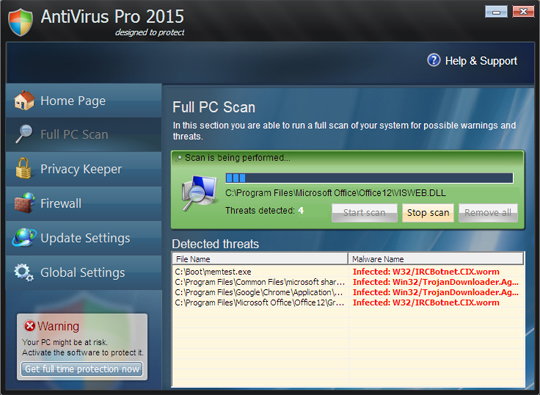
It also shows false firewall notifications:
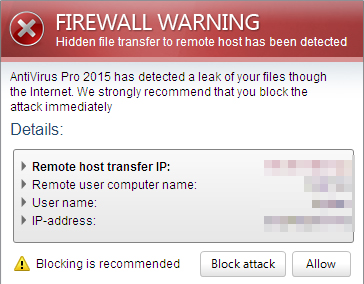
It periodically displays the following message in the system tray:
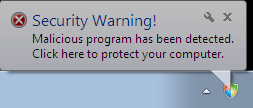
It also displays the following activation dialog box:
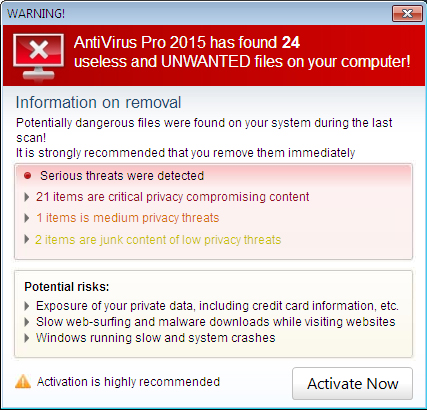
Upon clicking Activate Now, it connects to the following URLs to ask for payment:
- http://{BLOCKED}rem.com/{parameters}
- http://secure.{BLOCKED}auto.com:443
It then opens a fake antivirus purchase page:
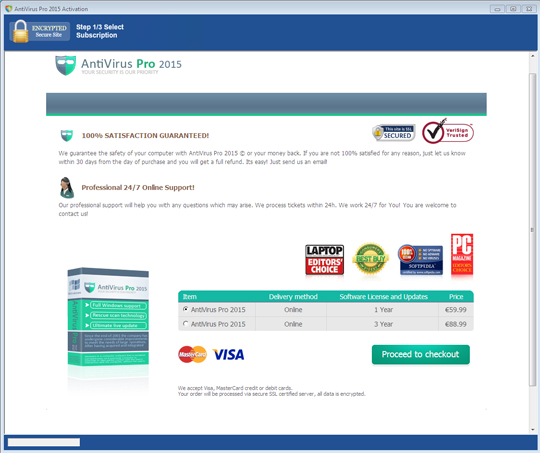
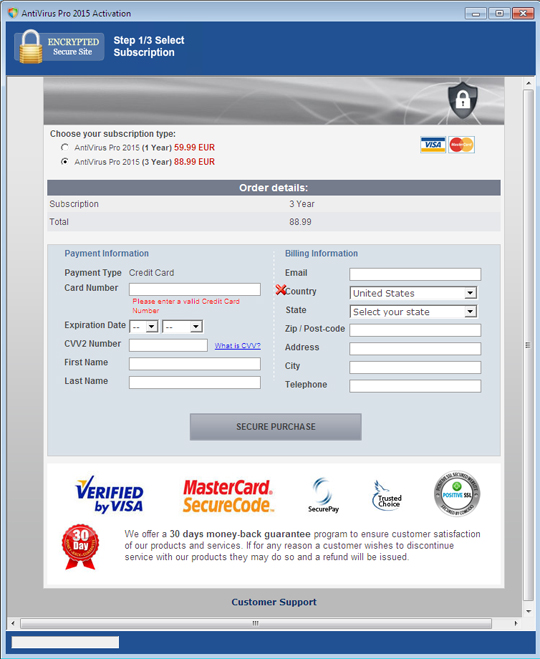
SOLUTION
Step 1
Before doing any scans, Windows XP, Windows Vista, and Windows 7 users must disable System Restore to allow full scanning of their computers.
Step 2
Scan your computer with your Trend Micro product and note files detected as TROJ_FAKEAV.YSXF
Step 3
Restart in Safe Mode
Step 4
Search and delete these files
- %User Temp%\d.bat
Step 5
Delete this registry value
Important: Editing the Windows Registry incorrectly can lead to irreversible system malfunction. Please do this step only if you know how or you can ask assistance from your system administrator. Else, check this Microsoft article first before modifying your computer's registry.
- In HKEY_CURRENT_USER\Software\Microsoft\Windows\CurrentVersion\Run
- diess.exe = "%Application Data%\diess.exe"
- diess.exe = "%Application Data%\diess.exe"
- In HKEY_CURRENT_USER\Software\Microsoft\Windows\CurrentVersion\Run
- AntiVirus Pro 2015 = "%Application Data%\diess.exe"
- AntiVirus Pro 2015 = "%Application Data%\diess.exe"
Step 6
Delete this registry key
=Important: Editing the Windows Registry incorrectly can lead to irreversible system malfunction. Please do this only if you know how to or you can seek your system administrator’s help. You may also check out this Microsoft article first before modifying your computer's registry.
- In HKEY_CURRENT_USER\Software
- {random}
- {random}
Step 7
Restart in normal mode and scan your computer with your Trend Micro product for files detected as TROJ_FAKEAV.YSXF. If the detected files have already been cleaned, deleted, or quarantined by your Trend Micro product, no further step is required. You may opt to simply delete the quarantined files. Please check this Knowledge Base page for more information.
Did this description help? Tell us how we did.

